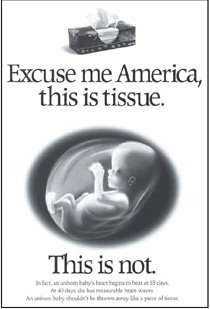Doctrine of Sanctity of Life Essential to Defense of Unborn
Dr. David P. Gushee of The Center for Bioethics & Human Dignity has been working on a "book project (CBHD/Eerdmans, 2008) which attempts a comprehensive intellectual exploration of the concept of the sanctity of life."
Gushee, an Evangelical Protestant Christian, is a Southern Baptist ethicist serving at a Tennessee Baptist university.
He writes a sketch of this project in his article reprinted below. He also offers a podcast of the same.
I'll be watching with great anticipation for more of this project. It offers tremendous potential in strengthening the foundations of our opposition to the taking of innocent human life in the womb.
This is important reading.
The Sanctity of Life by David P. Gushee, Ph.D.
The “sanctity of life” is a phrase that in recent decades became commonplace in the moral and political debates concerning a wide range of bioethical issues: abortion, embryo research, cloning, genetic engineering, euthanasia, and others. Generally it is used by those of us who oppose technologies or practices that we believe violate the intrinsic value of human life. Some of us who use the term employ it more broadly to denote an ethical approach concerned not just with a handful of bioethical issues but the entire range of moral problems that human beings face, from abortion to poverty, from war to the death penalty, from child abuse to the environment.
I am concerned that for many Christians “the sanctity of life” is little more than a culture wars slogan rather than the product of serious reflection. As a slogan it then evokes equally unthinking resistance from those who react negatively to anything that reminds them of (conservative) Christianity. And despite the thousands of uses of the term “sanctity of life” that can be found in any Google search, the phrase actually seems to be fading a bit from our consciousness. It feels a bit musty, a relic of the 1980s. This is most unfortunate.
I am at work on a book project (CBHD/Eerdmans, 2008) which attempts a comprehensive intellectual exploration of the concept of the sanctity of life. My contention is that this understanding of life’s worth is one of the crowning achievements of human civilization. It is the result of a very long historical journey through and beyond far less satisfactory visions of human moral obligation. It flows from the very best sources of our western cultural heritage (Jewish, classical, Christian, and modern) but simultaneously challenges other dimensions of these sources. It is a notion simultaneously sturdy and fragile—sturdy because it cannot be erased entirely from human consciousness and has withstood numerous ferocious challenges, fragile because it is all too easily set aside, rationalized away, or rejected.
One way of moving beyond slogans to a more substantive understanding of the sanctity of life is to define the term with some precision. This is my working definition: The concept of the sanctity of life is the belief that all human beings, at any and every stage of life, in any and every state of consciousness or self-awareness, of any and every race, color, ethnicity, level of intelligence, religion, language, gender, character, behavior, physical ability/disability, potential, class, social status, etc., of any and every particular quality of relationship to the viewing subject, are to be perceived as persons of equal and immeasurable worth and of inviolable dignity and therefore must be treated in a manner commensurate with this moral status.
Notice several things about this definition.
First, the sanctity of life is a concept that one believes in. It is, in other words, a moral conviction.
Second, it is a moral conviction about how human beings are to be perceived and treated. Belief in the sanctity of life prescribes a certain way of looking at the world, in particular its human inhabitants (with implications for its non-human inhabitants—a subject for another article). This perception then leads to behavioral implications related to how human beings are to be treated. Moral conviction leads to perception and flows into behavior. Notice that in constructing my understanding of the sanctity of life in this way I am emphasizing worldview dimensions first (convictions), character qualities next (perceptions), and behavioral prescriptions last. I think this is actually how the moral life works.
The third thing to notice about this definition is its universality. Rightly understood, the sanctity of life is among the broadest and most inclusive understandings possible of our moral obligations to other human beings.
All human beings are included (each and every human being), at all stages of existence, with every quality of experience, reflecting every type of human diversity, and encompassing every possible quality of relationship to the person who does the perceiving. What all are included in is a vision of their immeasurable worth and inviolable dignity. This means that each of these human beings has a value that transcends all human capacity to count or measure, which confers upon them an elevated status that must not be dishonored or degraded.
This breathtaking and exalted vision of the worth and dignity of human beings is what we mean, or ought to mean, when we speak of the sanctity of life. It is a moral conviction that continually challenges our efforts to weaken it. Yet weaken it we do, whether purposefully or unintentionally. Most often we weaken it when we chafe against the implications of its universality—its vision of the weak, the enemy, the disabled, the stranger, the unborn, the sinner, the poor, the ex-friend, the racial other, or whoever else we find it difficult to include within the community of the truly human.
Every effort to point out someone else’s violations of life’s sanctity implicitly requires us to examine our own fidelity to this exalted and demanding moral norm. This may be why the language of life’s sanctity has perhaps faded from public debate to some extent. Anti-abortion advocates who argued for the sanctity of (unborn) human life were met by anti-poverty advocates who argued for the sanctity of (born but poor) human life. Thoughtful moral theorists recognized that this was precisely right, and that a true understanding of life’s sanctity required a both/and rather than an either/or approach. But this hardly fits the culture wars paradigm. The sanctity of life is not so helpful as a political cudgel after all, which may mean its real value is as a bracing statement of human moral obligation.
So far I have not mentioned God. A question I will be exploring in the book is whether it is likely, or even possible, for belief in the sanctity of life to survive without belief in God—and a certain vision of God and God’s will, at that. The very word “sanctity,” from the Latin sanctus, which means sacred, holy, or inviolable, is redolent with religious connotations and implications. It is certainly possible to argue that the idea of the sanctity of human life is essentially a conferring of God’s holiness or sanctity onto the pinnacle of God’s creation, human beings. Humans can have sanctity because God their Creator and Redeemer does, or because God wills that they should be viewed and treated as such. It is an important question indeed to consider, as I will in the book, whether or not a conviction about human life’s sanctity can survive on the basis of a secularized vision of the foundations of that sanctity.


























0 Comments:
Post a Comment
<< Home